Related Research Articles

Miyabiyama Tetsushi is a former sumo wrestler from Mito, Ibaraki, Japan. A former amateur champion, he turned professional in 1998. With the exception of two tournaments, he was ranked in the top division of professional sumo from 1999 until the end of his career in 2013, holding the second highest rank of ōzeki from 2000 to 2001. He won eight special prizes and was runner-up in four top division tournaments. He wrestled for Fujishima stable, where he worked as a coach until opening his own Futagoyama stable.

Dejima Takeharu is a former sumo wrestler from Kanazawa, Ishikawa, Japan. A former amateur champion, he made his professional debut in 1996, reaching the top makuuchi division the following year. In July 1999 he won the yūshō or tournament championship and earned promotion to the second highest rank of ōzeki. He lost the rank in 2001 and, for the most part, remained a maegashira until his retirement in 2009. He won ten special prizes and six gold stars over his long career. He wrestled for Musashigawa stable. He is now an elder of the Japan Sumo Association under the name Ōnaruto Oyakata.
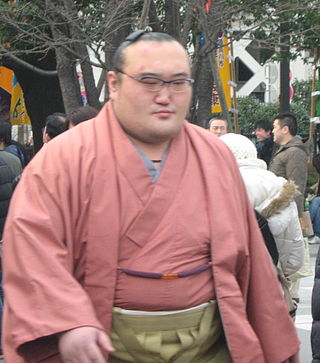
Iwakiyama Ryūta, is a former sumo wrestler. A former amateur sumo champion, he turned professional in 2000 and reached the top division at the end of 2002. The highest rank he reached was komusubi. He was a runner-up in one tournament and earned two special prizes in his career. After his retirement in 2010 he became an elder of the Japan Sumo Association under the name Sekinoto.

Tosanoumi Toshio, is a former sumo wrestler. He first reached the top division of professional sumo in 1995, winning 13 special prizes and earning 11 kinboshi or gold stars for defeating yokozuna over his long career. The highest rank he reached was sekiwake. He retired in 2010 to become a coach at his stable, Isenoumi stable under the name of Tatekawa.

Tamakasuga Ryōji is a former sumo wrestler from Seiyo, Ehime Prefecture, Japan. A former amateur sumo champion, he made his professional debut in 1994 and reached a highest rank of sekiwake in 1997. He fought in the top makuuchi division for twelve years, won five special prizes and earned seven gold stars for defeating yokozuna. He retired in 2008 and is now a sumo coach. In February 2010 he took over the running of Kataonami stable.

Tochisakae Atsushi is a former sumo wrestler from Saga Prefecture, Japan. He made his professional debut in 1993, reaching the top division for the first time in 2000. His highest rank was maegashira 1. He suffered many illness and injury problems throughout his career. He retired in 2008 and is now an elder of the Japan Sumo Association under the name of Mihogaseki, working as a coach at Kasugano stable.
Wakanoyama Hiroshi is a former sumo wrestler from Gobo, Wakayama Prefecture, Japan. His highest rank was komusubi.
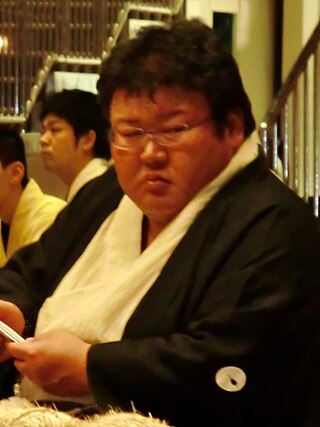
Daishōyama Naoki is a former sumo wrestler from Anamizu, Ishikawa, Japan. A former amateur champion, he made his professional debut in January 1989 and reached a highest rank of maegashira 2 before retiring in 1995. He is now the head coach of Oitekaze stable.
In 1999, Musashimaru firmly established his position as the dominant sumo wrestler of the year. Born in American Samoa and raised in Hawaii, Musashimaru became only the second foreign-born wrestler in history to achieve the highest rank of yokozuna or grand champion, in May 1999. He finished the year having won four tournaments, a rare accomplishment.
The following are the events in professional sumo in 1998.
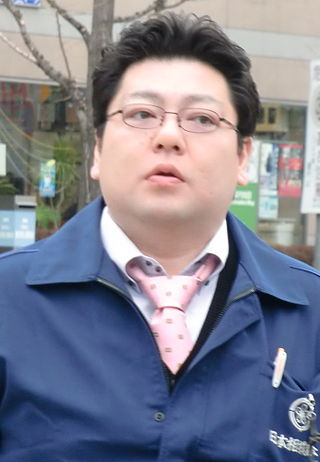
Gojōrō Katsuhiro is a former sumo wrestler from Aoba-ku, Sendai, Japan. Making his professional debut in 1989, he spent a total of 53 tournaments as an elite sekitori ranked wrestler, reaching a highest rank of maegashira 3 in 1998. After a number of injury problems he retired in 2005 at the age of 32. He is now a sumo coach under the name Hamakaze-oyakata.
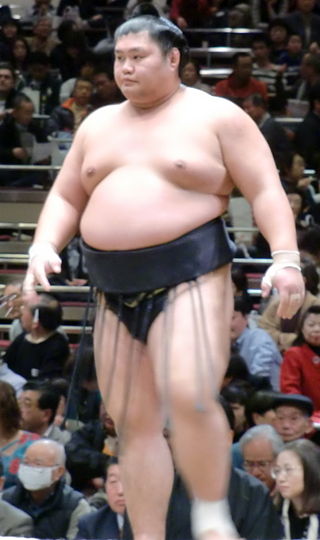
Wakakōyū Masaya is a former professional sumo wrestler from Funabashi, Japan. His highest rank was komusubi. The last two characters of his ring name were taken from his mentor and coach at Ōnomatsu, the former Masurao. He was only the second wrestler from his stable to reach the top division. He was runner-up in one tournament and earned one special prize, for Fighting Spirit. He is now a sumo coach.

Sadanofuji Akihiro is a former sumo wrestler from Kazusa, Nagasaki, Japan. He was a jūryō division champion in 2012. The highest rank he reached was maegashira 2. He retired in 2017 and was a coach at Sakaigawa stable under the name of Furiwake (振分) until 2024.
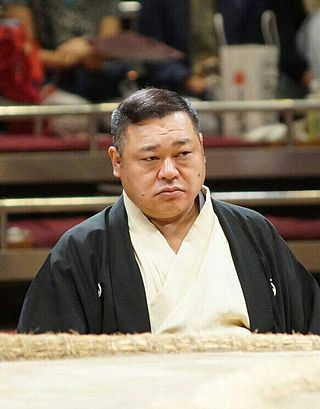
Aogiyama Hideki is a former sumo wrestler from Hikone, Shiga, Japan. He made his professional debut in March 1985, and reached the top division in March 1993. His highest rank was maegashira 1. He retired in November 2003, and he is an elder in the Japan Sumo Association under the name Edagawa.

Shikishima Katsumori is a former sumo wrestler from Funabashi, Chiba, Japan. He made his professional debut in January 1989, and reached the top division in November 1994. His highest rank was maegashira 1. He defeated Takanohana twice in 1998 to earn his only two kinboshi for a yokozuna upset. His stablemaster, former sekiwake Aonosato retired in November 2000 and he moved from Tatsutagawa stable to Michinoku stable. He retired in May 2001 after being diagnosed with a heart ailment, and has remained in sumo as an elder of the Japan Sumo Association and coach at Michinoku. He has borrowed a succession of elder names since his retirement. Since 2013 he has been known as Urakaze.
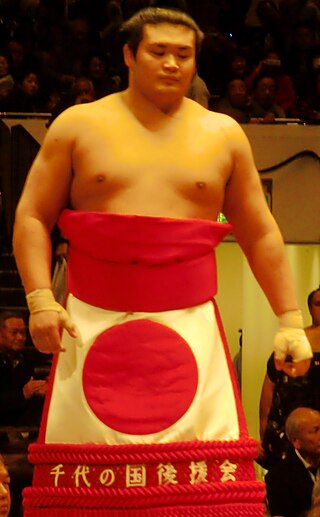
Chiyonokuni Toshiki is a Japanese former professional sumo wrestler from Iga, Mie. Making his professional debut in May 2006, he reached the top makuuchi division for the first time in January 2012. He has a highest rank of maegashira 1, but he has also been restricted by injuries, falling to the sandanme division in 2015 before staging a comeback, and then once again having serious injury in 2019 sending him down the ranks. He made a final comeback which saw him stagnate in the second half of the jūryō division before his demotion and retirement. He is a member of Kokonoe stable where he is an elder under the name Sanoyama.

Wakasegawa Yoshimitsu was a sumo wrestler from Sakata, Yamagata, Japan. He made his professional debut in 1978, reaching the top makuuchi division for the first time in 1983. His highest rank was maegashira 1. He retired in 1992 and worked in the restaurant business after leaving sumo.
Shinji Hamada, better known as Toyonoumi Shinji, was a Japanese sumo wrestler from Buzen, Fukuoka. He made his professional debut in March 1981 and reached the top division in November 1988. He was known by the shikona Takanohama until 1990. His highest rank was maegashira 1. He did not miss a single bout in his 19-year professional career. Upon retirement from active competition he became an elder in the Japan Sumo Association, under the name Yamahibiki. He left the Sumo Association in June 2002.
Terunoumi Masato, also known as Daikikō Masato, born Masato Hayashi, was a sumo wrestler from Gobō, Wakayama, Japan. A former amateur champion, he made his professional debut in 1990. His highest rank was maegashira 15. He was the first wrestler in the six tournaments per year era to reach the top makuuchi division after spending just one tournament in the second highest jūryō division. After injury problems he retired in 1993, and died at the age of 41 in 2009.

Amakaze Kōichi is a Japanese professional sumo wrestler from Kotohira, Kagawa. He made his professional debut in March 2007, joining Oguruma stable, and reached the top makuuchi division in September 2016. His highest rank has been maegashira 13. He has one jūryō division championship or yūshō.
References
- ↑ "Who's who - Asanosho". Nihon Sumo Kyokai. Archived from the original on 18 February 2013. Retrieved 4 September 2012.
- ↑ "Asanosho Hajime Rikishi Information". Sumo Reference. Retrieved 4 September 2012.